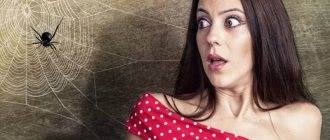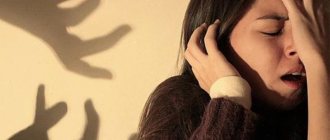Among the many toys, dolls stand out. All girls and even some boys love to play with dolls. Some adults also love dolls: some collect them, others make them, and still others like to visit doll exhibitions. But there are people who not only don’t like, but are terrified of these toys. In psychology, such fear is called pediophobia. Let's figure out what this disorder is and what are the causes of its occurrence.
Why are people afraid of dolls
The cause of pediophobia must be sought in early childhood. The child endows the toy with human qualities; it seems to him that it pretends to be inanimate, but in fact it watches over him, feels everything, and comes to life at night. Because of this, the child is afraid of accidentally dropping her, hurting her, or making her angry. Some kids are afraid to turn their backs and be alone.
Of course, not all children behave this way, but only suspicious, vulnerable, mentally unstable or suggestible ones. Fear can arise after watching horror films about toys that come to life, listening to mystical stories and horror stories. Even watching a harmless cartoon, such as Toy Story, can result in new fears for an anxious child.
Pediophobia, other causes of development:
- Childhood psychotrauma. The child lost his favorite toy or accidentally broke it. For young children, dolls are friends. Breakage or loss can cause feelings of guilt or fear that the “friend” will take revenge. The situation gets worse if the parents punish the child for breaking something.
- Fright at the sight of a doll. Another version of psychotrauma. Not all humanoid toys look attractive, and creating disgusting or scary dolls is actually one of the branches of art. Getting to know such a toy can result in trauma for a child.
- Associations with death. Realistic and wax figures are frightening because they are very similar to people, but do not move or breathe. Which does not cause the most pleasant associations.
- Fear of clones, artificially created people, humanoid robots. A specific reason that is associated with the genetic and biological characteristics of a person. At the level of the subconscious and connection with distant ancestors, we are all afraid of artificially grown people. This is contrary to human nature, but in the understanding of some individuals it is also dangerous. They are afraid that the situation will get out of control and new creatures will harm humanity.
- Superstitions, belief in poltergeists, otherworldly forces. The combination of suggestibility, suspiciousness and passion for horror films can lead to the fact that any rustle or creaking in the house will be attributed to the actions of the doll. It is this plot that is often used by the creators of horror films, and history knows of cases when dolls allegedly actually committed atrocities. The most striking example is Annabelle. Urban legend says she was possessed by an evil spirit. A film was even made based on this legend.
- The use of dolls in magical rituals. A striking example is a Voodoo doll. The individual is afraid of becoming a victim of black magic. He believes that a rag likeness of a person is a conductor between the other world and real people. The patient is afraid that he will be damaged or harmed.
It is important! If childhood fears are not addressed immediately, they go to the subconscious level and manifest themselves as phobias in adulthood.
What is pediophobia
Pediophobia is a mental disorder expressed in the form of a strong panic fear of dolls. There is also another disorder – glenophobia. This is the fear of a doll's gaze. The patient feels as if the toy is watching him with its eyes.
Pediophobia manifests itself differently in different people. Some people are afraid of all dolls in a row, while others experience panic attacks only when meeting specific specimens. The intensity of fear also varies from mild anxiety to real terror.
In the modern world, we are surrounded by many dolls: children's toys on store shelves, mannequins in shopping centers, all kinds of humanoid robots. It is not easy for pediophobes to live in such a world, so they try at all costs to avoid dolls. Women deprive themselves of the pleasure of shopping, men refuse to get acquainted with the latest robotics, parents do not buy dolls for their children. At first glance, fear of dolls seems like an insignificant disorder, but upon closer examination, it significantly worsens the quality of life.
Manifestations of phobia
Characteristic manifestations of a phobia:
- Avoidance of meeting the object of fear. The patient walks around toy stores a kilometer away, trying to avoid encountering dolls and mannequins. He will never go to a puppet theater, will not participate in a cultural event, a walk where frightening characters may appear. A person doesn’t talk about dolls; if he sees an image on TV, he immediately changes the channel.
- With direct contact with the object of the phobia, somatic symptoms are observed: shortness of breath, a feeling of suffocation, chest pain, hand tremors, chills, increased heart rate, dry throat, trembling, nausea, dizziness. All this is accompanied by panic. In advanced stages of phobia, panic attacks occur, during which the patient experiences fear of death or fear of going crazy. At this time, a feeling of unreality of what is happening appears; the patient cannot adequately perceive reality.
- Attempts to escape. Once near a frightening object, the patient will do everything to leave the room as quickly as possible. He may even become aggressive, especially if someone tries to restrain him or put an object of fear into his hands.
It is important! The more advanced the fear of dolls or the closer the patient comes to the doll, the more severe the symptoms.
Pathogenesis
The mental disorder is based on features of clown costumes and makeup that exaggerate facial features and individual body parts, including hands, legs and noses. These body deformations can be perceived by a person not only comically, but also frighteningly, since they are too similar to a person. These experiences can develop into a phobia, especially in mentally unstable people and in particular in children. In addition, human fear of clowns is fueled by their inappropriate (antisocial) behavior, which seems ridiculous, rude, as well as the image of the “evil clown” created by the authors in films and books, for example, the clown Pennywise.
Interesting! After the publication of books (in particular “It” by Stephen King in 1985) and the release of films exploiting the image of the “evil clown”, literally in just a few decades they managed to root it in the mass consciousness to such an extent that the founders of the British Bestival festival had to cancel it in 2006 planned clown theme, as many people who bought tickets contacted them and spoke about their coulrophobia. All these phenomena cause irreparable damage to the profession of a jester.
A 2008 study by the University of Sheffield found that many children (approximately 80%) find clowns “terrifying and incomprehensible”, so most do not want them in hospital decor, clothing or at children's events.
Mechanism of development of phobia
Psychologists have not yet come to a consensus on how the fear of dolls develops. The famous psychoanalyst Sigmund Freud believed that the problem should be looked for in childhood. And he considered the main prerequisite to be a peculiarity of the child’s psyche - the inability to distinguish the doll world from reality.
There is also another type of phobia formation - indirect associations. For example, a child got lost in a large city square during a holiday, where there were many life-size dolls, humanoid statues, sculptures, and monuments. Over time, the memories of the situation will be erased, but the connection between the intense fear and the dolls will remain. The second possible option: the child became ill in the toy store, or he quarreled with his mother, or she punished the child. Thus, the cause of a phobia can be any unpleasant situation in which dolls were present, and the child accidentally caught his eye on them, and an incorrect cause-and-effect relationship formed in the brain.
Celebrities with Pediaphobia
Among famous personalities there are open pediaphobes:
- Emily Blunt. Her fear began in childhood, when she did not expect to see garden gnomes on the neighbor's lawn. Over the years, this situation has developed into a fear of figurines made in the shape of a person.
- Actor Ashton Kutcher acquired his fear while watching his wife's hobby of collecting dolls.
- Chad Michael Murray also developed a phobia from observing his grandmother's porcelain doll collection.
Girl and toy
Fear is a very vivid emotion that is rarely forgotten. Any adult can easily remember how, in his distant childhood, he was scared by a dog or a stranger. From childhood, you need to be careful with gifts for children, to avoid sudden surprises with firecrackers and the sudden appearance of a clown, until the child consciously asks for it. All problems and fears follow a person from childhood. A wise parent can preserve the mental health of his child.
How to overcome phobic fear yourself
Psychologists do not recommend ignoring alarming symptoms and trying to overcome fear by willpower. However, you can cope with a mild and active form of phobia on your own.
Psychologist's advice
During the conversation, the specialist finds out the characteristics of the disease, collects anamnesis, and examines the client’s life history. If necessary, he conducts additional testing. Tests, like other diagnostic methods, as well as the treatment program are selected on an individual basis. The average course of treatment is one year. But it all depends on the moment the therapy begins and the client’s condition at that moment.
Treatment uses neurolinguistic programming, cognitive behavioral psychotherapy, hypnosis, training, and group classes. The psychologist helps the client realize the irrationality of fear, understand that only he controls the situation, and develop new strategies of behavior. If the client is in critical condition, then drug therapy (antidepressants, tranquilizers, sedatives, antipsychotics) is prescribed.
It is important! The phobia is based on an unresolved, unprocessed situation from the past. It is almost impossible to get to the truth on your own. Therefore, it is recommended not to aggravate the condition further, but to immediately consult a psychotherapist.
How to deal with the fear of dolls on your own
First of all, you need to admit that there is a problem. This can be especially difficult for men. After this, try to remember when you first felt fear. Maybe it was some kind of situation from childhood or another horror movie I watched recently. You need to analyze the situation with an adult eye. It is useful to master relaxation methods, self-regulation, breathing exercises and auto-training. It is recommended to avoid watching horror films.
Drug treatment
To normalize the state of mind, some names of natural medicines can be cited: hawthorn tincture; Dill water; chamomile decoction; tea based on mint and lemon balm. The herbal plants listed have a proven calming effect on the human nervous system and can help in complex therapy with individual sessions with a psychotherapist.
If a patient experiences severe nervous disorders, accompanied by a distortion of reality, he is sent to a medical institution, where, under the supervision of specialists, potent drugs are prescribed. The duration of such treatment depends on the severity of the disease and the depth of susceptibility of each individual patient.
Antidepressants may also help. The puppet's fear often becomes a cause of ridicule for others, which adds unbearability to the patient himself. Contacting a medical institution to see a psychiatrist may result in a recommendation for treatment with drugs for prolonged depression. Such drugs should not be used uncontrolled; during rehabilitation, the patient must regularly visit a specialist who monitors his condition.
The danger and consequences of a phobia
A pediophobe cannot calmly walk through a shopping center; he will never buy a toy for his child. And meeting a doll in someone’s hands on the street can trigger the onset of panic.
As the phobia develops, the psychophysical symptoms also intensify. Complication options:
- disorientation;
- distorted perception of reality;
- altered state of consciousness;
- hallucinations;
- problems with hearing and vision.
Relationships with colleagues and close people deteriorate. The person becomes desocialized. Secondary disorders often develop, such as paranoia, schizophrenia, dissociative identity disorder, psychosis, social phobia and sociopathy. Constant tension leads to the development of psychosomatic diseases.
The desire to destroy a frightening object can lead to dangerous consequences for the patient himself and other people. For example, he may set fire to a toy store, attack a child, or get hit by a car while running away.
General information
Coulrophobia is a pathological fear of clowns and mimes . It is considered a generally recognized phobia and is listed in the International Classification of Diseases, 10th Revision (ICD-10) under the code F40.2 of specific (isolated) phobias limited to very limited situations.
Many people don’t know what the fear of clowns is called, but after the release of the film “Harry Potter and the Prisoner of Azkaban” this problem was given wider publicity. The term coulrophobia refers to neoholism and comes from the Greek word “colbatbristes” - translated as walking on stilts.
Phobias should be strictly distinguished from delusions. With phobic syndrome, the patient is clearly aware of the obsessive, painful nature of the fear that overcomes him, which is a distinctive feature of the neurotic level of disorders.
Still from the film “Harry Potter and the Prisoner of Akaban”











